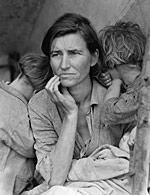
Unit 5: Crisis and Change
Lesson E: Economic Depression and Political Collapse
Lesson Overview
The Great Depression resulted in huge drops in industrial production and stock market share prices. Many considered the Great Depression to be a sign of the failure of capitalism. The interdependent global economy that had been built following World War I splintered as governments across the globe sought to protect their respective countries from the effects of the Great Depression. Governments scrambled to retain revenues and support their citizens. Citizens everywhere suffered personal losses of all kinds and endured long periods of unemployment. Banks and companies around the world failed. The beginning of the Great Depression and the beginning of recovery from economic depression were different for different countries, but, for most, the Great Depression started around 1929 and lasted well into the late 1930s or even into the 1940s and the beginning of World War II.
Key Questions
- How did the conflicts and crises of the first half of the 20th century become global in nature?
- How did the conflicts and crises of the first half of the 20th century impact the world?
- How did the conflicts and crises of the first half of the 20th century reshape political and economic global power structures?
Student Outcomes
- Analyze the financial, economic, and social causes of the Depression and why it spread to most parts of the world.
- Assess the human costs of the Depression and compare its impact on the economies and societies in different countries, including its impact on colonial peoples of Africa and Asia.
- Analyze how the Depression contributed to the growth of socialist and communist movements and how it affected capitalist economic theory and practice in capitalist nations.
- Describe how governments, businesses, social groups, families, and individuals addressed the hardships of the Depression.
- Explain how the Soviet Union was able to become an industrial power and progress economically during the Depression.
- Assess the impact of the Great Depression on the rise of authoritarian regimes in Europe, Asia, and Latin America.
- Formulate historical questions. (Historical Thinking Skill)
- Interrogate historical data. (Historical Thinking Skill)
- Identify the gaps in the available records; marshal contextual knowledge and perspectives of the time and place. (Historical Thinking Skill)
- Support interpretations with historical evidence. (Historical Thinking Skill)
Key Terms
- balance of international trade
- demand
- depression
- free market
- gold standard
- Gross Domestic Product (GDP)
- interest rate
- interventionism
- personal income
- populism
- price
- profit
- reparations
- supply
- tariff
- taxes
- unemployment rate
- welfare
Student Resources
- Blank World Map (pdf)
- Comparing Capitalism and Marxism (doc)
- Responses to the Great Depression - Snapshots of Nations (pdf)
- Responses to the Great Depression Jigsaw Factsheets (pdf)
- Responses to the Great Depression Jigsaw Graphic Organizer (doc)
- Great Depression Brief Constructed Response (BCR) (doc)
Chart of Activities:
| Activities to Complete | Estimated Time |
|---|---|
| Pre-Assessment | 10 minutes |
| Key Terms | 10 minutes |
| Activator: The World in Depression – 1929-1936 | 15 minutes |
| Opening: Economic Principles and Their Relevance to Citizens | 15 minutes |
| Activity 1: Economic Responses | 15 minutes |
| Activity 2: Causes of the Great Depression | 20 minutes |
| Activity 3: Comparing Capitalism and Marxism | 25 minutes |
| Activity 4: Impacts and Choices around the World | 10 minutes |
| Activity 5: The Gold Standard | 10 minutes |
| Activity 6: Responses to the Great Depression | 30 minutes |
| Activity 7: The Great Depression and World War II | 10 minutes |
| Activity 8: Causes and Effects of Great Depression: Discussion | 20 minutes |
| Review and Assessment | 20 minutes |
| Lesson Summary | 5 minutes |
Lesson Completion Time
The total estimated time to complete this lesson is 215 minutes.
Page Notes:
[1] Source: This image from http://en.wikipedia.org/wiki/File:Lange-MigrantMother02.jpg is in the public domain.



